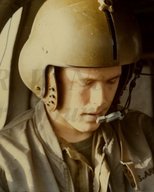
|

|
|
|
|
A native Californian, Larry was one of three children of a World War II Navy veteran and career man, William Ralph Hinton, and Violet Cathy Hinton. During his post-war career, William moved his family from one duty station to another. By the late 1960s they were in Wetumpka, Alabama, where his father retired. Larry worked for area farmers in their fields in "grunt work", and also helped his father set up television antennae. Larry graduated from Wetumpka High School in 1968. The draft and college were his choices after graduation. Not interested in college he joined the army, hoping to become a helicopter pilot. Meanwhile his brother, who joined the navy, served in Vietnam as a .50-caliber gunman on a slider boat. After enlisting in Montgomery, he was sent to Fort Jackson, South Carolina for basic training, then to Fort Devens near Ayer, Massachusetts for AIT. His training was delayed when he contracted pneumonia. He first went to manual Morse Code School, and learned to send code in 18 words per minute. He then went on to Radio Direction School and learn how to find a radio transmitter. Then, in analyst school, the entire class got orders to Vietnam. His brother, however, learned of his destination and informed his chaplain that two brothers were not to be in the same combat area. So Larry went to another school and became an analyst for artillery firing. When his brother left Vietnam, Larry was to follow. He attended Target Orientation School in Petaluma, California. He then went to Udon, Thailand where he was a member of the Quick Reaction Force and served as perimeter guard with an M60 machine gun. He was in a Radio Research Group, with the mission to detect Russian teletype, as well as Chinese, Burmese, Laotian and Vietnamese. The recorders in the room (which he estimates was 75 yards long) were "recording every cotton-picking frequency that was on the radio and they'd sent all that back to NSA. He recalls duty as 24/7, with 8- and 12-hour shifts. After one year he was sent to Okinawa for six weeks of general warfare school. He arrived in Vietnam on Christmas Day 1970, and was sent to the 371st Radio Research Company at Phouc Vinh. A job wasn't available for him at the time, so he went on two missions with Special Forces. He was hit in the ankle by mortar fire in his last mission in a firefight. Because of the Vietnamization process, the Radio Research was winding down. He was given a choice of going to another unit or to fly. "I wanted to fly," he recalls. Larry went to the 138th Aviation Company in Phu Bai where he flew in propeller airplanes (the U-8 and U-21). Missions would last two to four hours. The crews never wore parachutes. "Our mission was classified and if we went down you went down with the airplane. I had a M16 and a life raft and that was it in the back of the airplane," Larry remarks. He and the crew would identify enemy in the field. "We'd fly in a circle around them and keep as many shots on them as possible before either `A' they went down or they knew we were there," he recalls. Larry would be in the 05H position of identifying and copying the enemy messages as he flew. Once, he got emergency leave to Guam, where his father, who was working for NASA, was stationed and his mother was diagnosed with cancer (but survived). He stayed a week and then returned to Vietnam. He left the country a month early (he believes in October of 1971) to a testing evaluation center at Fort Huachuca in Arizona for Army Security Agency Flight DF School. He flew a Pan Am flight to Oakland. "I'd been gone for two years. I had no idea what was going on in the States," he recalls. "I pulled up there and got off the plane and people looked at you like you were dirt.... They didn't want to have anything to do with you; didn't even want to walk next to you. So it was an eye opener," he recalls. He was eventually discharged at Fort Huachuca, getting out six months early because of the winding down of the Vietnam War. Larry settled in Alexandria, Louisiana where his parents were located. On January 19, 1974 he married Wanda Robichaux, whom he had met on a blind date. (They would have two children and four grandchildren.) He worked at Davidson Fashion Builder, a type of lumber company. He then went to work at the Alexandria Fire Department where he remained for 35 years. He retired in 2007. |


